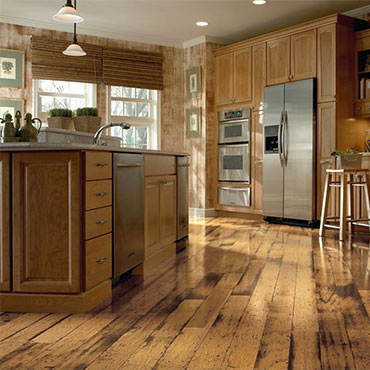Distressed Wood Flooring

Rustic Charm Meets Modern Elegance: The Renaissance of Distressed Wood Flooring in Contemporary Interior Design
In the ever-evolving world of interior design, the allure of rustic elegance has found a prominent place through the resurgence of distressed wood flooring. This unique flooring style, blending old-world charm with modern sophistication, has become a favored choice for designers, decorators, and homeowners alike. In this article, we delve into the world of distressed wood flooring, exploring its types, species, and the myriad ways it enhances interior spaces.
What is Distressed Wood Flooring?
Distressed wood flooring refers to
hardwood that has undergone specific treatments to achieve an aged, weathered look. This process involves physical distressing techniques, such as scraping, brushing, and creating dents and scratches, giving the wood an antique appearance. The result is a floor that boasts character and history, making each plank distinctively unique.
Types and Species
Distressed wood flooring comes in various types and species, each offering its unique aesthetic and textural qualities. Common types include:
- Hand-Scraped Wood: Craftsmen manually scrape the wood, creating undulations and ridges that mimic centuries-old flooring.
- Wire-Brushed Wood: This type involves brushing the wood with stiff bristles, revealing the natural grain and creating a rugged texture.
- Footworn Wood: Mimicking the effect of years of foot traffic, this type features softened edges and gentle wear patterns.
Popular species for distressed wood flooring include oak, maple, pine, and walnut, each contributing different grain patterns, color tones, and durability levels.
Versatility and Durability
Distressed wood flooring's beauty lies in its versatility. It seamlessly integrates with various design themes, from rustic farmhouses to contemporary urban lofts. Moreover, its inherent imperfections make it highly forgiving, effectively masking everyday wear and tear, thus being an excellent choice for high-traffic areas.
Durability is another significant aspect of distressed wood flooring. The treatment processes it undergoes often enhance its resilience, making it capable of withstanding the rigors of daily life while maintaining its aesthetic appeal.
Sustainability and Environmental Impact
In the current climate of environmental consciousness, distressed wood flooring often scores high on sustainability. Many manufacturers source wood from sustainable forests or use reclaimed wood, which not only reduces environmental impact but also adds to the authenticity and story of the flooring.
Enhancing Interior Spaces
The aesthetic appeal of distressed wood flooring lies in its ability to add warmth, texture, and a sense of history to interior spaces. Its varied tones and textures make it a versatile backdrop for a wide range of furnishings and décor styles. Additionally, its unique appearance can become a focal point in a room, adding character and depth.
Selection Insights for Design Professionals
For interior designers, decorators, and design consultants, selecting the ideal distressed wood flooring involves considering several factors:
- Room Usage: Understand the traffic and usage of the space to choose the right species and distressing level.
- Color and Grain: Match the wood’s color and grain pattern with the room’s overall color scheme and style.
- Plank Size: Larger planks can make a room feel more spacious, while smaller planks offer a more traditional look.
- Finish: Choose between matte, satin, or glossy finishes based on the desired ambiance and maintenance requirements.
Features and Benefits
The features of distressed wood flooring include its unique aesthetic, durability, and ease of maintenance. The benefits range from its ability to hide scratches and dents, making it pet and child-friendly, to its contribution to a space's overall design narrative.
Recent Trends and Innovations
The recent trends in distressed wood flooring involve blending traditional techniques with modern finishes, creating floors that are both rustic and sophisticated. Innovations include the use of eco-friendly materials and finishes, as well as the incorporation of reclaimed wood for an authentic aged look.
Conclusion
Distressed wood flooring stands at the intersection of tradition and innovation, bringing a timeless appeal to modern interiors. Its versatility, durability, and aesthetic charm make it a preferred choice for those looking to infuse spaces with character and warmth. For design professionals, it offers a canvas for creativity, allowing the merging of historical richness with contemporary design elements. As this flooring style continues to evolve, it undoubtedly will remain a staple in the world of interior design.
Disclaimer: The information provided in this article is for general informational purposes only. While we strive to ensure the accuracy and reliability of the information presented, we make no warranties, express or implied, about the completeness, accuracy, reliability, suitability, or availability with respect to the content. Any reliance you place on such information is strictly at your own risk. We recommend consulting with professionals for specific advice tailored to your project’s needs, particularly regarding building codes, regulations, and product specifications.
Under no circumstances shall we be liable for any loss or damage, including without limitation, indirect or consequential loss or damage, arising from the use of, or reliance on, the information provided in this article.







